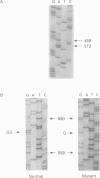Abstract
In our analysis of mutations causing DHPR deficiency we identified a patient in whom there was an aberrant transcription pattern detected by PCR of DHPR cDNA. However, unlike the pattern observed as a result of most splicing mutations, there is some full length transcript. The mutation was located and is a single nucleotide deletion at position 570/571 of the DHPR cDNA sequence and results in a frameshift and premature termination after the addition of six amino acids. The mutation is present in a homozygous state in the patient and in a heterozygous state in both parents. The exon which is deleted at high frequency in the patient is the putative exon 4, which is remote from the mutation, and confirms our observation that exon 4 skipping is a relatively common event.
Full text
PDF



Images in this article
Selected References
These references are in PubMed. This may not be the complete list of references from this article.
- Bachmann B., Lüke W., Hunsmann G. Improvement of PCR amplified DNA sequencing with the aid of detergents. Nucleic Acids Res. 1990 Mar 11;18(5):1309–1309. doi: 10.1093/nar/18.5.1309. [DOI] [PMC free article] [PubMed] [Google Scholar]
- Craine J. E., Hall E. S., Kaufman S. The isolation and characterization of dihydropteridine reductase from sheep liver. J Biol Chem. 1972 Oct 10;247(19):6082–6091. [PubMed] [Google Scholar]
- Dahl H. H., Hutchison W., McAdam W., Wake S., Morgan F. J., Cotton R. G. Human dihydropteridine reductase: characterisation of a cDNA clone and its use in analysis of patients with dihydropteridine reductase deficiency. Nucleic Acids Res. 1987 Mar 11;15(5):1921–1932. doi: 10.1093/nar/15.5.1921. [DOI] [PMC free article] [PubMed] [Google Scholar]
- Danks D. M., Schlesinger P., Firgaira F., Cotton R. G., Watson B. M., Rembold H., Hennings G. Malignant hyperphenylalaninemia--clinical features, biochemical findings, and experience with administration of biopterins. Pediatr Res. 1979 Oct;13(10):1150–1155. doi: 10.1203/00006450-197910000-00014. [DOI] [PubMed] [Google Scholar]
- Dianzani I., Howells D. W., Ponzone A., Saleeba J. A., Smooker P. M., Cotton R. G. Two new mutations in the dihydropteridine reductase gene in patients with tetrahydrobiopterin deficiency. J Med Genet. 1993 Jun;30(6):465–469. doi: 10.1136/jmg.30.6.465. [DOI] [PMC free article] [PubMed] [Google Scholar]
- Kaufman S., Milstien S., Bartholomé K. Letter: New forms of phenylketonuria. Lancet. 1975 Oct 11;2(7937):708–708. doi: 10.1016/s0140-6736(75)90806-5. [DOI] [PubMed] [Google Scholar]
- Matsubara Y., Ikeda H., Endo H., Narisawa K. Dried blood spot on filter paper as a source of mRNA. Nucleic Acids Res. 1992 Apr 25;20(8):1998–1998. doi: 10.1093/nar/20.8.1998. [DOI] [PMC free article] [PubMed] [Google Scholar]
- Miller S. A., Dykes D. D., Polesky H. F. A simple salting out procedure for extracting DNA from human nucleated cells. Nucleic Acids Res. 1988 Feb 11;16(3):1215–1215. doi: 10.1093/nar/16.3.1215. [DOI] [PMC free article] [PubMed] [Google Scholar]
- Senapathy P., Shapiro M. B., Harris N. L. Splice junctions, branch point sites, and exons: sequence statistics, identification, and applications to genome project. Methods Enzymol. 1990;183:252–278. doi: 10.1016/0076-6879(90)83018-5. [DOI] [PubMed] [Google Scholar]
- Smooker P. M., Howells D. W., Cotton R. G. Identification and in vitro expression of mutations causing dihydropteridine reductase deficiency. Biochemistry. 1993 Jun 29;32(25):6443–6449. doi: 10.1021/bi00076a018. [DOI] [PubMed] [Google Scholar]
- Walker D. C., McCloskey D. A., Simard L. R., McInnes R. R. Molecular analysis of human argininosuccinate lyase: mutant characterization and alternative splicing of the coding region. Proc Natl Acad Sci U S A. 1990 Dec;87(24):9625–9629. doi: 10.1073/pnas.87.24.9625. [DOI] [PMC free article] [PubMed] [Google Scholar]





